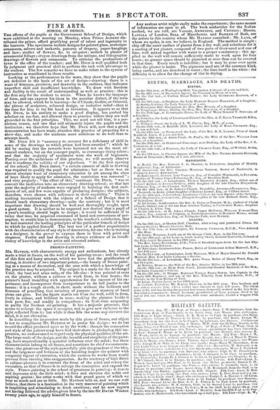FINE ARTS.
SCHOOL OF DESIGN.
Tax efforts of the pupils at the Government School of Design, which were exhibited at the meeting on Monday, when Prince ALBERT dis- tributed the prizes, afford gratifying proof of talent and ingenuity in the learners. The specimens include designs for painted glass, arabesque ornaments, salvers and tankards, patterns of drapery, paper-hangings and lace ; studies of flowers, &c. in oil-paint ; models in plaster of ornamental foliage ; crayon drawings from the antique, and lithographic drawings of flowers and ornaments. To criticize the productions of tyros is the office of the teacher ; and Mr. DYCE is well qualified both by judgment and practical skill to perform the task with advantage to the student. The few remarks we have to make relate to the system of instruction as manifested in these results.
Looking at the performances in the mass, they show that the pupils are deficient in the basis of the art of design—drawing : there is a want of firmness, precision, and dexterity in the outlines, that indicates imperfect skill and insufficient knowledge. To draw with freedom and facility is the result of understanding as well as practice : this is the first step for the student to attain. When he knows the language of form, and can express his ideas in the peculiar dialect, if the term may be allowed, which he is learning—be it Classic, Gothic, or Oriental, the phrase of sculpture, coloured design, or imitative relief—then is the time for him to try his hand at invention. It appears to us that Mr. DYCE, in his anxiety to make a good display, has pushed his scholars on too fast, and allowed them to practice before they are well grounded in the first principles. This, we need not tell him is a per- nicious course, and one that will ultimately injure the pupils and the institution : we therefore hope that Mr. Dzcz will, now that a grand demonstration has been made, abandon this practice of preparing for a show-day, and make the students more solicitous to do well than to attempt much.
Mr. DYCE felt it "necessary to account for a deficiency of skill in some of the drawings to which prizes had been awarded ' : which he did by stating that the rewards were bestowed not on the most ad- vanced students, but on the younger pupils, to encourage rising talent ; and that the majority of specimens were the work of beginners. Passing over the unfairness of this practice, we will merely observe that it confirms the validity of our objections. " At the first opening of the school," Mr. DYCE stated, " a certain amount of skill in drawing was required to qualify the pupil for admission ; but as there was an almost absolute want of elementary education in art among the class of boys likely to apply for admission, the restriction was removed " ; and very properly : " the effect of this," continues Mr. DYCE, " was to convert the institution into an elementary drawing-school ; so that last year the majority of students were engaged in learning the first rudi- ments of art, and few were capable of producing designs ; the subjects, therefore, were chosen with reference to their capability." There is nothing inconsistent with the objects of a School of Design that it should teach elementary drawing—quite the contrary ; but it is most important that drawing should be well and thoroughly taught, upon a good system. It is neither to be expected nor desired that a pupil of a year's standing should begin to design : it would be sufficient if in twice that time he acquired command of hand and correctness of per- ception, to enable him to demonstrate, to his teacher's satisfaction, that he had mastered the leading principles of the particular branch of design to which he applied himself. The best test of a perfect acquaintance with the characteristics of any style of decoration, for one who is training as a designer, is the power to express them in lines with point and elegance. Feeble and bad drawing is always evidence of an insuffi- ciency of knowledge in the artist and educated artisan.


























 Previous page
Previous page